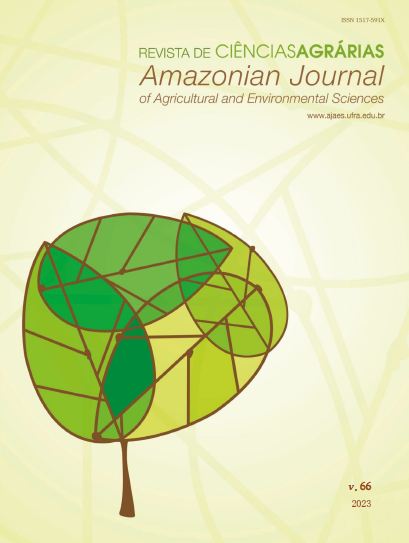Silicon as attenuator of excess ammonium in papaya seedlings
Abstract
The excess of ammonium has a harmful effect on plant development, however the use of silicon can reduce its toxicity. Given the above, the objective was to characterize the symptoms of ammonium toxicity, diagnose its effects on the growth and nutritional status of papaya seedlings, and verify the effect of silicon as a stress reliever. The experiment was carried out in a greenhouse at UNESP – Campus de Jaboticabal-SP, Brazil. The experimental design used was a randomized block design in a 4x2 factorial scheme, with four concentrations of ammonium (7.5, 15, 30 and 60 mmol L-1), and in the absence and presence of silicon, with four replications. The silicon source used was monosilicic acid and the ammonium source was ammonium chloride. Visual symptoms of ammonium toxicity, evaluations of plant height, stem diameter, green color index, leaf area, electrolyte leakage, shoot and root dry matter were characterized, and N, Ca, accumulation was also calculated. Mg and K in shoots. The excess of ammonium resulted in visual symptoms of toxicity, namely: reduced growth, leaf necrosis in older leaves, chlorosis and wrinkling in younger leaves. There was an increase in electrolyte leakage and resulted in less nutrient absorption. Silicon acted as a beneficial element in mitigating the physiological stress caused by excess ammonium.
Downloads
References
BATAGLIA, O. C.; FURLANI, A. M. C.; TEIXEIRA, J. P. F.; FURLANI, P. R.; GALLO, J. R. Métodos de análise química de plantas. Campinas: Instituto Agronômico de Campinas, 1983, 48p. (Boletim Técnico, 78).
BARRETO, R. F.; CRUZ, F. J. R.; GAION, L. A.; PRADO, R. M.; CARVALHO, R. F. Accompanying ions of ammonium sources and nitrate : ammonium ratios in tomato plants. Journal of Plant Nutrition and Soil Science, v. 181, p.382-387, 2018.
BARRETO, R. F.; PRADO, R. M.; LEAL, A. J. F.; TROLEIS, M. J. B.; SILVA JUNIOR, G. B.; MONTEIRO, C. C.; SANTOS, L. C. N.; CARVALHO, R. F. Mitigation of ammonium toxicity by silicon in tomato depends on the ammonium concentration. Acta Agriculturae Scandinavica, Section B - Soil and Plant Science, v. 66, p.483-488, 2016.
BARRETO, R. F.; SCHIAVON JÚNIOR, A. A.; MAGGIO, M. A.; PRADO, R. M. Silicon alleviates ammonium toxicity in cauliflower and in broccoli. Scientia Horticulturae, v. 225, p. 743-750, 2017.
BITTSÁNSZKY, A.; PILINSZKY, K.; GYULAIB, G.; KOMIVES, T. Overcoming ammonium toxicity. Plant Science, v.231, p.184-190, 2015.
BORGOGNONE, D.; COLLA, G.; ROUPHAEL, Y.; CARDARELLI, M.; REA, E.; SCHWARZ, D. Effect of nitrogen form and nutrient solution pH on growth and mineral composition of self-grafted and grafted tomatoes. Scientia Horticulturae. v.49, n.1, p.61–69, 2013.
BYBORDI, A. Influence of NO3-:NH4+ ratios and silicon on growth, nitrate reductase activity and fatty acid composition of canola under saline conditions. African Journal of Agricultural Research. v.5, n.15, p.1984-1992, 2010.
CAMPOS, C. N. S. Silício e excesso de amônio e de nitrato em plantas de cana-de-açúcar e de pepino. 2013. 72 f. Dissertação (Mestrado em produção vegetal) – Faculdade de Ciências Agrárias e Veterinárias, Universidade Estadual Paulista “Júlio de Mesquita Filho”. Jaboticabal. 2013.
COLETO, I.; VEGA-MAS, I.; GLAUSER, G.; GONZÁLEZ-MORO, M. B.; MARINO, D. E.; ARIZ, I. New Insights on Arabidopsis thaliana Root Adaption to Ammonium Nutrition by the Use of a Quantitative Proteomic Approach. International Journal of Molecular Sciences, v. 20, p.814, 2019.
DEUS, A. C. F.; PRADO, R. M.; ALVAREZ, R. D. C. F.; OLIVEIRA, R. L. L; FELISBERTO, G. Role of silicon and salicylic acid in the mitigation of nitrogen deficiency stress in rice plants. Silicon, v. 1, p. 9, 2019.
DIONISIO-SESE, M. L.; TOBITA, S. Antioxidant responses of rice seedlings to salinity stress. Plant Science, v. 135, p.1-9, 1998.
EPSTEIN, E. Silicon: its manifold roles in plants. Annals of Applied Biology, v.155, p. 155–160, 2009.
ESTEBAN, R.; ARIZ, I.; CRUZ, C. E.; MORAN, J. F. Mechanisms of ammonium toxicity and the quest for tolerance. Plant Science, v. 248, p. 92-101, 2016.
FARSHIDI, M.; ABDOLZADEH, A.; SADEGHIPOUR, H. R. Silicon nutrition alleviates physiological disorders imposed by salinity in hydroponically grown canola (Brassica napus L.) plants. Acta Physiologiae Plantarum, v.34, n.5, p. 1779–1788, 2012.
FERREIRA, D. F. Sisvar: a computer statistical analysis system. Ciência e Agrotecnologia. v 35, n. 6, p.1039-1042, 2011.
HOAGLAND, D.R.; ARNON, D. I. The water culture method for growing plants without soil. Berkeley: California Agicultural Expeimental Station, 1950, 347p.
JAMPEETONG, A.; BRIX, H.; KANTAWANICHKUL, S. Response of Salvinia cucullata to high NH4+ concentrations at laboratory scales. Ecotoxicology and Environmental Safety, v. 79, p.69–74, 2012.
JIAO-JING, L.; SHAO-HANG, L.; PEI-LEI, X.; XIU-JUAN, W.; JI-GANG, B. Effects of exogenous silicon on the activities of antioxidant enzymes and lipid peroxidation in chilling-stressed cucumber leaves. Agricultural Sciences in China, v. 8, n. 9, p. 1075-1086, 2009.
LIMA, M. A.; CASTRO, V. F.; VIDAL, J. B.; ENÉAS-FILHO, J. Aplicação de silício em milho e feijão-de-corda sob estresse salino. Revista Ciência Agronômica. v.42, n.2, p.398-403, 2011.
MATEOS-NARANJO, E.; ANDRADES-MORENO, L.; DAVY, A. J. Silicon alleviates deleterious effects of high salinity on the halophytic grass Spartina densiflora. Plant Physiology and Biochemistry. v.63, p.115-121, 2013.
Copyright (c) 2023 Gilmara Pereira da Silva, Renato de Mello Prado , Juliana Jordão Boiago, Hermenegildo Lucas Justino Chiaia

This work is licensed under a Creative Commons Attribution-NonCommercial 4.0 International License.
Authors retain copyright and grant the Journal the right to the first publication. Authors are encouraged to and may self-archive a created version of their article in their institutional repository, or as a book chapter, as long as acknowledgement is given to the original source of publication. As the Journal provides open access to its publications, articles may not be used for commercial purposes. The contents published are the sole and exclusive responsibility of their authors; however, the publishers can make textual adjustments, adaptation to publishing standards and adjustments of spelling and grammar, to maintain the standard patterns of the language and the journal. Failure to comply with this commitment will submit the offenders to sanctions and penalties under the Brazilian legislation (Law of Copyright Protection; nº 9,610; 19 February 1998).


.jpg)









